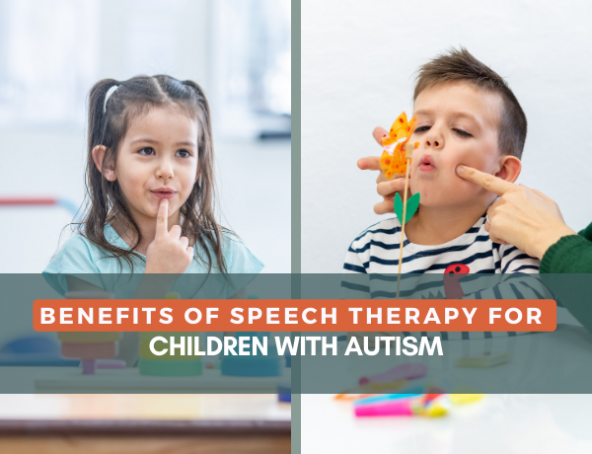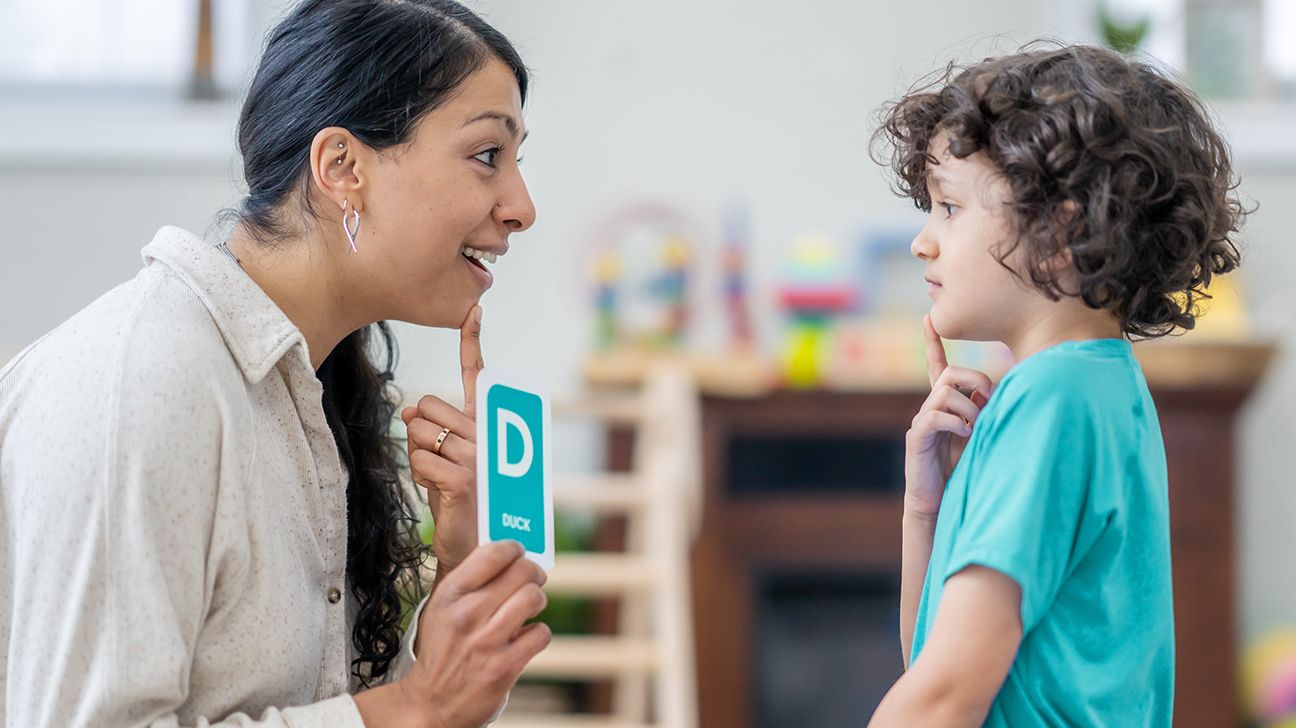Are you looking for effective ways to support your autistic child in developing their speech and communication skills? Navigating the world of speech therapy can feel overwhelming, but you’re not alone.
Many parents like you are eager to help their children express themselves more clearly and confidently. Imagine the joy of hearing your child articulate their thoughts and feelings, bridging the gap between their inner world and the outside. In this guide, you’ll discover practical strategies and insights tailored to your child’s unique needs.
Get ready to unlock the secrets to empowering your child with the gift of communication, and watch as their world—and yours—opens up in new and meaningful ways.

Credit: www.sarahdooleycenter.org
Understanding Autism In Children
Speech therapy aids communication skills in autistic children. Tailored approaches focus on interaction, comprehension, and expression. Engage children with visual aids and simple instructions to enhance learning.
Understanding autism in children is essential for anyone involved in their care and development. Autism Spectrum Disorder (ASD) affects each child differently, yet there are common threads that can help you better understand their needs. Recognizing these traits is the first step in offering effective speech therapy.
Common Characteristics
Children with autism often display unique behaviors and ways of interacting with the world. They may have a strong preference for routines and can become upset with changes. Some children might exhibit repetitive movements like hand-flapping or rocking. They may also have intense interests in specific topics or objects. While these characteristics can be challenging, they also provide insights into how your child sees the world. Understanding these behaviors can help you tailor your approach to therapy.
Communication Challenges
Communication is often one of the primary challenges for children with autism. Some children may be non-verbal, while others might struggle with understanding social cues or maintaining a conversation. You might notice that your child repeats phrases or words they hear, a behavior known as echolalia. It’s crucial to recognize that these challenges are not barriers but opportunities to develop unique communication strategies. What methods have you found effective in encouraging communication? Sharing experiences can be a powerful tool for learning. By focusing on their strengths and interests, you can create a supportive environment that encourages growth and confidence.

Credit: azaunited.org
Setting Goals For Speech Therapy
Setting goals in speech therapy for autistic children is crucial. It helps track progress and makes therapy effective. Goals provide direction and purpose. They ensure each session builds on the last. This section will guide you through creating goals that are meaningful and achievable.
Individualized Therapy Plans
Every child is unique. Their therapy plan should reflect their needs. Start by assessing the child’s strengths and challenges. Use this information to tailor a plan. Involve the child and their family in this process. Understanding their perspective is vital. It ensures the plan is relevant and motivating.
Short-term And Long-term Goals
Short-term goals focus on immediate improvements. They are stepping stones to bigger achievements. These goals might include simple tasks. Like pronouncing a new word correctly. Long-term goals aim for significant changes. They might involve complex skills. Such as holding a conversation. Balance both types for effective therapy.
Creating A Supportive Environment
Creating a supportive environment is essential for speech therapy with autistic children. Use simple language and visual aids to encourage communication and understanding. Make sure the setting is calm and free from distractions to foster focus and progress.
Creating a supportive environment is crucial when providing speech therapy to an autistic child. This environment can significantly impact their ability to focus and engage during sessions. As you set the stage for effective learning, consider how the physical space and sensory elements can enhance comfort and communication.
Safe And Comfortable Spaces
Every child needs a space where they feel secure. Start by choosing a location free from loud noises and distractions. Think about a room with soft lighting and comfortable seating. These elements can make a child feel more at ease. Imagine yourself in a space filled with calmness. Wouldn’t it be easier to concentrate and express yourself? Your child is no different. Creating a predictable routine in this space can also help. Knowing what to expect can reduce anxiety, making it easier for your child to communicate.
Incorporating Sensory Tools
Many autistic children respond well to sensory tools. These can include textured toys, weighted blankets, or noise-canceling headphones. Consider how these tools might help your child feel more grounded. A weighted blanket might provide a sense of security, while noise-canceling headphones can reduce overwhelming sounds. Have you noticed your child getting anxious with bright lights? Soft, dim lighting might be the solution. Think of sensory tools as allies in creating a supportive environment. They can be the difference between a distracted session and one filled with progress. As you integrate these elements, observe your child’s reactions. Each small adjustment can lead to significant changes in their speech therapy journey. Creating a supportive environment is all about understanding your child’s needs. What changes can you make today to foster a more engaging space for their growth?
Effective Techniques For Speech Therapy
Engaging an autistic child in speech therapy requires a thoughtful approach. You can make the process enjoyable and effective by using techniques that resonate with the child’s unique needs. Let’s dive into some practical and impactful methods that can help you along this journey.
Using Visual Aids
Visual aids are like a bridge to understanding for many autistic children. Pictures, flashcards, and charts can simplify complex ideas. For instance, a picture schedule can help a child anticipate what comes next, reducing anxiety and enhancing focus.
Consider using colorful images or symbols that relate to the child’s interests. This can make communication more relatable and engaging. What kind of visual tools have you tried with your child?
Interactive apps are another fantastic resource. They often combine visuals with sounds and motions, providing a multi-sensory experience. Explore different options to see which ones your child responds to best.
Incorporating Play
Play is not just fun; it’s a powerful tool in speech therapy. Children often learn best when they are relaxed and having a good time. Use games and role-playing to encourage verbal interactions.
Consider a simple game of ‘Simon Says’ to practice following instructions and vocalization. You might be surprised at how this playful approach can spark communication.
Remember a time when your child was particularly engaged in a game? Use that memory to guide your therapy sessions. Tailor activities to your child’s interests to keep them motivated and excited.
Engage your child in pretend play, like playing house or store. This can naturally bring out language skills as they interact with you or their peers. What imaginative activities does your child enjoy?
Speech therapy doesn’t have to be daunting. By using techniques like visual aids and play, you can create an environment where your child feels supported and eager to communicate. What other methods have you found effective in your journey?
Building Trust And Rapport
Creating a safe environment is crucial for effective speech therapy with autistic children. Establishing trust helps them feel comfortable and supported. Building rapport fosters communication and encourages progress in therapy sessions.
Building trust and rapport with an autistic child is crucial for effective speech therapy. It’s about creating a safe environment where they feel understood and valued. You need to connect with them on a personal level, understanding their unique needs and preferences. This bond can make therapy sessions more productive and enjoyable for both you and the child.
Consistent And Predictable Sessions
Consistency is key in speech therapy. Autistic children often thrive on routine and predictability. Set a specific time and place for your sessions. This helps the child know what to expect and reduces anxiety. Regular sessions build familiarity and comfort. Try to keep the structure of each session similar. Begin with a warm greeting, followed by a quick review of previous activities. This helps establish a rhythm that the child can rely on.
Positive Reinforcement
Celebrate small victories with positive reinforcement. Praise their efforts and achievements, no matter how minor. This boosts their confidence and motivates them to engage more. Use rewards that the child enjoys. It could be verbal praise, a sticker, or a favorite toy. Tailor your reinforcement to what resonates with them personally. Ask yourself, how can you make the child feel accomplished? The answer lies in recognizing their progress and encouraging their efforts consistently. Building trust and rapport is not just about therapy; it’s about making the child feel seen and heard. How will you make this connection meaningful?

Credit: www.healthline.com
Engaging With Parents And Caregivers
Building a strong connection with parents and caregivers is essential in speech therapy for autistic children. Open communication ensures understanding and support, fostering a collaborative environment for progress. Regular updates and feedback help caregivers stay informed and actively participate in the therapeutic process.
Engaging with parents and caregivers is crucial in speech therapy for autistic children. Their involvement ensures consistency and reinforces learning beyond therapy sessions. Building a partnership with them enhances the child’s progress and confidence.
Collaborative Strategies
Therapists and parents should work together to set clear goals. Discuss and agree on strategies that suit the child’s needs. Regular communication helps track progress and adjust methods. Jointly celebrate small victories to motivate everyone involved.
Providing Resources And Support
Offer parents educational materials to understand autism and speech therapy. Share tips and techniques they can use at home. Recommend support groups where they can connect with other families. Encourage them to share their experiences and learn from each other. “`
Adapting To Individual Needs
Tailoring speech therapy for an autistic child requires understanding their unique communication style. Create a supportive environment by using visual aids and gestures. Engage in activities that cater to their interests, encouraging interaction and progress.
Adapting speech therapy for an autistic child requires understanding and patience. Every child is unique. Their needs and responses to therapy vary. A customized approach ensures better outcomes. Adapting to individual needs is key. This involves using flexible techniques and closely monitoring progress.
Flexibility In Techniques
Therapists should use varied methods. Visual aids can be helpful. Some children learn better through images. Others prefer auditory cues. Use stories and songs. They can make sessions engaging. Play-based learning is also effective. It helps children express themselves. Different activities cater to different learning styles. This keeps the child interested.
Monitoring Progress
Track each child’s progress. Keep detailed notes after every session. Observe changes in communication skills. Adjust strategies based on these observations. Regular assessments are crucial. They highlight areas of improvement. Also, they point out areas needing more focus. Share progress with parents. This keeps everyone informed. It helps in creating a supportive environment at home.
Common Challenges And Solutions
Speech therapy for autistic children presents unique challenges. Each child is different, with diverse needs and abilities. Understanding common obstacles can aid in creating effective strategies. This section discusses frequent challenges in speech therapy and offers practical solutions. Overcoming these hurdles can lead to significant progress in communication skills.
Dealing With Non-verbal Communication
Many autistic children rely on non-verbal cues. They may struggle with spoken words. Encourage the use of gestures, pictures, or sign language. These tools help express needs and emotions. Visual supports can bridge the communication gap. Consistent practice enhances understanding and confidence. Reinforce successful communication attempts with praise or rewards.
Handling Behavioral Issues
Behavioral challenges can disrupt therapy sessions. Understand triggers that lead to meltdowns or distractions. Create a calm and predictable environment. Offer clear and simple instructions. Use a structured routine to reduce anxiety. Positive reinforcement encourages desired behaviors. Address sensory sensitivities by adjusting the environment. Tailor approaches to suit each child’s unique needs and preferences.
Frequently Asked Questions
How To Do Speech Therapy With Autism?
Use visual aids and simple language. Practice social skills through role-playing. Incorporate interests to engage attention. Consistently reinforce positive behavior. Collaborate with a professional therapist for tailored strategies.
What Is The Average Age For Autistic Children To Talk?
Autistic children often begin talking between ages 3 to 4. Speech development varies widely among individuals. Early intervention and therapy can help improve communication skills. Always consult a specialist for personalized guidance.
What Is The Most Effective Treatment For Autism?
Applied Behavior Analysis (ABA) is considered the most effective treatment for autism. It improves communication, social skills, and behavior. Early intervention and personalized programs enhance its effectiveness. Consult professionals for tailored strategies. Therapy varies by individual needs. Always seek guidance from healthcare providers for optimal results.
How To Improve Autistic Child Speech?
Use speech therapy and engage in interactive play. Encourage verbal communication through songs and reading. Use visual aids to support understanding. Create a structured and supportive environment. Regular practice and patience are key.
Conclusion
Helping an autistic child with speech therapy can be rewarding. Celebrate small victories every day. Be patient and consistent. Tailor activities to the child’s interests. Use clear and simple language. Practice regularly and keep sessions short. Encourage communication through games and play.
Build a supportive environment at home. Listen to the child’s needs and adapt your approach. Consult professionals for guidance when necessary. Speech therapy is a journey, not a race. Progress takes time, but dedication leads to improvement. Parents, caregivers, and therapists can make a real difference together.
Stay hopeful and committed.
